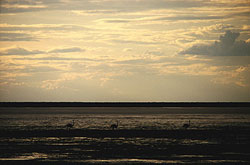Investigating the deposition of biogenic particles on sediments
Urged by obligations of European countries to international treaties on environmental protection issues, the ORFOIS project studied extensively the origin and fate of biogenic particle fluxes in the ocean. Additionally, the particles' interaction with the atmospheric CO2 concentration and marine sediments was another important aspect of the project's research work. The involved studies, accumulated data-set and developed models are expected to provide valuable means for the reliable prediction of surface ocean CO2 sources and sinks. Until now, the role of coastal ocean and river depositional environments as sinks of nutrients has not been clearly defined. Existing studies in Amazon deltaic system displayed that silica particles upon deposition to the sediments undergo rapid conversion to cation-rich alumoninosilicate phases. These can cause the formation of new cation-rich aluminosilicate phases, which may be important sources of major cations (K, Mg), minor elements (F) and nutrients (Si) internationally. During these cation uptake reactions, a feedback mechanism, where CO2 consumed during silicate weathering on land is returned from oceans to the atmosphere takes place. One of the key project results is the study of the importance of biogenic silica as a substrate for the formation of newly formed aluminosilicate phases in two deltaic systems. Thereby, the reactive silica content in sediments of Ganges-Brahmaputra and Mississippi was identified using standard and modified operational analytical methods. On the basis of these models both fresh, unaltered biogenic silica (BSi) and altered biogenic silica particles, as well as, other authigenic aluminosilicate phases were measured. The newly derived results and the already existing were extrapolated to the global coastal ocean showing that deltaic systems constitute major sinks of riverine dissolved silica. Additionally, the role of newly formed cation rich aluminosilicate phases on siliceous substrates as a CO2 source to the atmosphere on geologic time scales was also estimated. For more information click at: http://www.pangaea.de/Projects/ORFOIS/(odnośnik otworzy się w nowym oknie)



